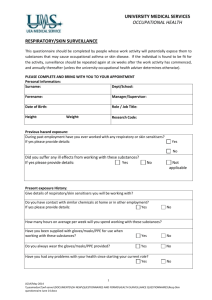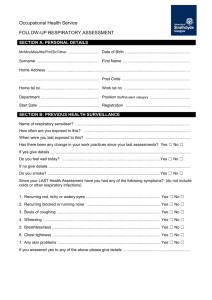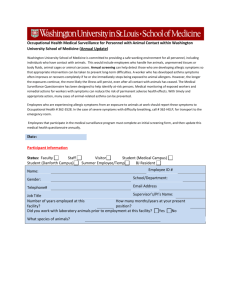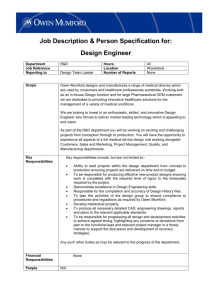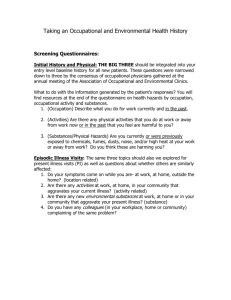OBUHSN-39 - Oxford Brookes University
advertisement
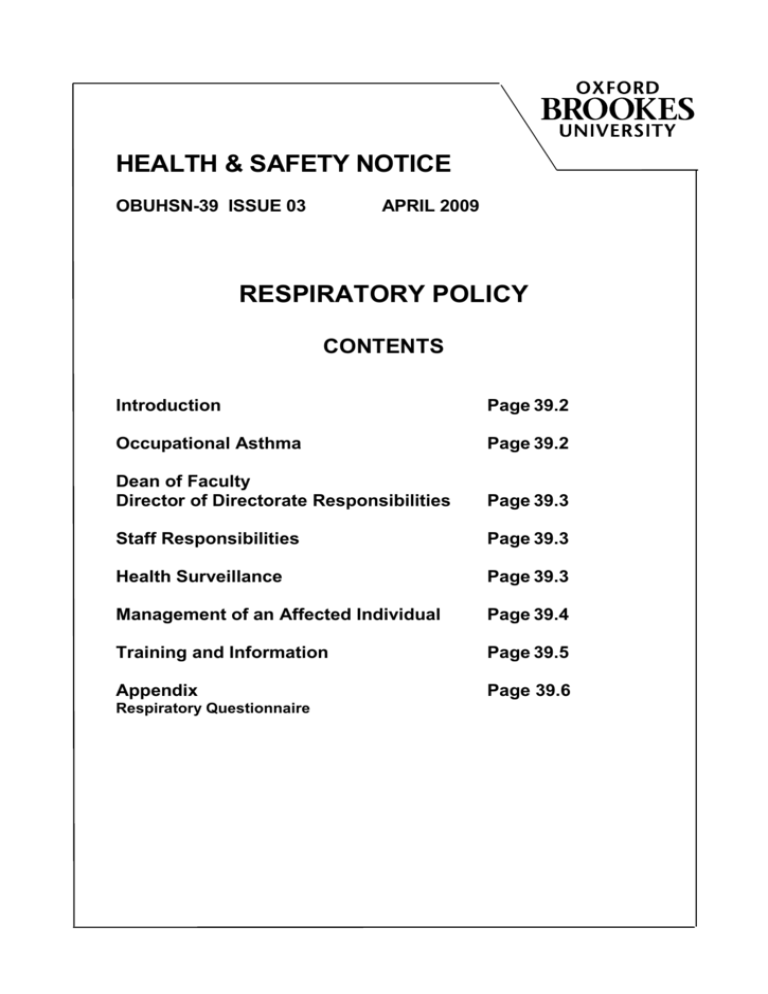
HEALTH & SAFETY NOTICE OBUHSN-39 ISSUE 03 APRIL 2009 RESPIRATORY POLICY CONTENTS Introduction Page 39.2 Occupational Asthma Page 39.2 Dean of Faculty Director of Directorate Responsibilities Page 39.3 Staff Responsibilities Page 39.3 Health Surveillance Page 39.3 Management of an Affected Individual Page 39.4 Training and Information Page 39.5 Appendix Page 39.6 Respiratory Questionnaire RESPIRATORY POLICY INTRODUCTION 1. This health and safety notice must be read and understood by all employees of Oxford Brookes University likely to be involved in work activities that bring them into contact with processes, products or substances that may have a damaging effect on their breathing. Where applicable, it should also be read by all members of the student body. 2. This policy is written to demonstrate that Oxford Brookes University has an effective health surveillance programme for any members of staff who are identified as being exposed to known hazardous substances during their work activities and early recognition of cases where previously unsuspected causative agents are being used. 3. Adequate health surveillance is a requirement under the Control of Substances Hazardous to health Regulations (COSHH) and Management of Health and Safety at Work Regulations (MHSW). Health surveillance involves monitoring staff by implementing systematic, regular and appropriate procedures to detect early signs of work-related ill health among those exposed to particular health risks. 4. The University recognises its responsibility to safeguard the safety health and welfare of its staff and students. This requires it to take all practicable measures to ensure that the conditions of work do not cause, exacerbate or contribute to damage to the lungs or via the lungs to damage of the internal organs of the body. OCCUPATIONAL ASTHMA 5. Occupational asthma is an occupational health problem that can result in severe asthma attacks and chronic disability. The disease is characterised by attacks of breathlessness, wheezing and coughing. These symptoms are often accompanied by conjunctivitis (itchy, inflamed eyes) and rhinitis (blocked or runny nose). 6. Occupational asthma is caused by an allergic reaction to a specific substance inhaled by the individual at work. The risk of developing occupational asthma varies from one substance to another and there is no clear pattern of exposure leading to the disease although the greater the exposure to a substance, the greater the likelihood of developing occupational asthma. The time taken for symptoms to develop varies between individuals, but in many cases symptoms develop within a few months of first exposure. Once occupational asthma due to a particular agent has developed, subsequent exposure to very low concentrations of the substance can provoke an asthmatic attack. OBUHSN-39 Issue 03 39.2 DEAN OF FACULTIES’, DIRECTOR OF DIRECTORATE’S RESPONSIBILITIES 7. All Deans of Faculty/Directors of Directorates must ensure that an adequate workplace COSHH assessment or risk assessment is carried out to identify the presence of substances known to cause asthma and other health problems. This responsibility may be delegated to line managers competent in performing such assessments. Anyone exposed to such substances should be referred to Occupational Health for the appropriate form of health surveillance. Advice regarding risk assessments may be sought from the health and Safety Division or from OBUHSN-19. STAFF RESPONSIBILITIES 8. It is the responsibility of all staff working with products or processes identified as potentially damaging to the lungs to co-operate with the University in relation to this health and safety notice. In particular this will include adherence to the agreed working practices, reporting any problems that arise from the working practices and correct use and care of personal protective equipment/respiratory protective equipment PPE/RPE provided. Detailed information on PPE is given in OBUHSN-21 8.1 It is the responsibility of any member of staff who is supervising a student working with products or processes identified as potentially damaging to the lungs to adequately induct the student in the safe working practice and use of PPE/RPE provided. HEALTH SURVEILLANCE 9. Health surveillance is considered appropriate when exposure to a substance hazardous to health is known to have the potential to cause an identifiable disease and that there is a reasonable and valid method of detection available. An occupational health nurse or, where indicated, an occupational health physician will carry out the health surveillance. 10. The precise form of health surveillance required will depend on the circumstances of exposure and the measures put in place within the working environment to minimise the effects following the risk assessment. In most instances the health surveillance will take the form of the following: OBUHSN-39 Issue 03 39.3 11. 10.1 A pre-employment or pre-placement medical will be carried out for any individual in a work environment with known hazardous substances. This will involve taking history on known allergies, smoking habit, previous occupational history and any previous chest problems, Appendix 1. Base-line lung function and peak flow readings will be taken. The individual will be provided with information about potential symptoms and to report to Occupational Health if they suspect they are suffering from them. 10.2 At 6 weeks after starting work in the area, a questionnaire for identifying relevant symptoms will be completed together with a further lung function test, Appendix 2. 10.3 At 12 weeks after starting work in the area, a further questionnaire for identifying relevant symptoms will be completed together with a further lung function test, Appendix 2. 10.4 Annually thereafter, the same procedure as at 6 and 12 weeks will be followed. It is a requirement under COSHH to keep and maintain a health record of the health surveillance for at least 40 years from the last date of entry. Adequate and appropriate records of the health surveillance will be kept within the Occupational Health Department. MANAGEMENT OF AN AFFECTED INDIVIDUAL 12. If a case of occupational asthma is suspected by the outcome of health surveillance, the individual will be referred to the University’s Occupational Physician to identify whether the symptoms are likely to be related to work and the substance likely to be causing the asthma. Additionally, information will be sought on the individual’s fitness to continue to work in the same role with or without certain precautions or whether alternative employment should be sought. If alternative employment is recommended, every effort will be made by Human Resources by means of redeployment should appropriate work be available elsewhere in the University. 13. The Deans of Faculty/Directors of Directorates will ensure that line management undertake a review of the COSHH assessment and control measures in place in the area where the affected individual was working to consider whether increased controls are necessary. OBUHSN-39 Issue 03 39.4 14. In some cases, the use of personal respiratory protective equipment (RPE) may be sufficient to control exposure and allow the individual to continue work with no detriment to their health. However, RPE must only be used as a measure of last resort and in conjunction with other measures to control exposure. The RPE provided must be properly fitted and maintained and the individual given adequate training and information about its use. Such individuals will need to continue with regular health surveillance to monitor the effectiveness of such control measures. TRAINING AND INFORMATION 15. Appropriate information and training must be provided to enable those using hazardous substances to comply with the health and safety measures in place. This training should include general education on the nature and risks to health of the substances being used and the precautions to be taken including signs of lung disease, health surveillance, training in safe working practices, the correct use and care of PPE/RPE and reporting procedures for any problems identified. 16. Training is available from the Senior Occupational Health Advisor or the Safety Officer. Approved by: Issued by: ....................................... (Vice-Chancellor) ...................................... (Safety Officer) Date:....../......./.....…. OBUHSN-39 Issue 03 39.5 ...................................... (Senior Occupational Health Advisor) APPENDIX 1 Pre-placement Baseline Respiratory Questionnaire Section 1 Surname Forenames Faculty/Directorate Length of employment in current role Do you work with any of the following Date Date of Birth Yes / No Frequency Animals/insects Gluteraldehyde Wood Dust Epoxy resins/glues Iscocyanates Nickel, cobalt, chromium, platinum Solder colophony Latex Flour / grain Previous exposure? Any Exposure at home? Do you use protective equipment when working with the substances identified Yes / No If so, please give details: Are you Currently Suffering from? Yes / No Periods of breathlessness Wheezing or chest tightness Persistent or frequent coughing Sore or watering eyes Sneezing, blocked/running nose Rash or skin irritation If yes, please give details: OBUHSN-39 Issue 03 39.6 Have you suffered from any of the following? Yes / No Hay fever Rhinitis Asthma Skin conditions (eczema, dermatitis, urticaria) Allergies to ant substances If yes, please give details Have you any blood relatives who suffer from any of the above? Yes / No If yes, please give details Have you received treatment for any allergic symptoms? Yes / No If yes, please give details Do you smoke If yes, how many per day? Are you and ex-smoker? If and ex-smoker, when did you stop? Yes / No Yes / No Please give details of any previous Occupational Health history Signature: OBUHSN-39 Issue 03 Date 39.7 Section 2 For departmental use only PRE-TEST CHECKLIST Have had any of the following? Cold air exposure in the last 2 hours? Shortness of breath on exertion in the last two hours? Surgery, in the last 6 months Medical treatment, current or recent? Hypertension / hypotension? Cardio-vascular problems URTI, current / recent Cough, current / recent Ear problem Last cigarette Other OBUHSN-39 Issue 03 39.8 APPENDIX 2 Pre-placement Baseline Respiratory Questionnaire Section 1 Surname Forenames Faculty/Directorate Date Date of Birth Are you still working with any of the following Yes / No Animals/insects Gluteraldehyde Wood Dust Epoxy resins/glues Iscocyanates Nickel, cobalt, chromium, platinum Solder colophony Latex Flour / grain Has this increased or decreased? In the past months, have you suffered from any of the following? Periods of breathlessness Wheezing or chest tightness Persistent or frequent coughing Sore or watering eyes Sneezing, blocked/running nose Rash or skin irritation If yes, please give details: Signature: OBUHSN-39 Issue 03 Date 39.9 Frequency Section 2 For departmental use only PRE-TEST CHECKLIST Have had any of the following? Cold air exposure in the last 2 hours? Shortness of breath on exertion in the last two hours? Surgery, in the last 6 months Medical treatment, current or recent? Hypertension / hypotension? Cardio-vascular problems URTI, current / recent Cough, current / recent Ear problem Last cigarette Other OBUHSN-39 Issue 03 39.10
